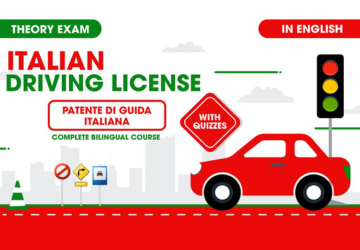Italian Driving License Theory Preparation Course with Quizzes
in Patente A, B in EnglishAbout this course
About Course
This course has been designed by industry professionals with over twenty years of experience. It provides all the essential materials to help you study each argument, practice with quizzes, and finally simulate the complete Patente A-B exam with confidence.
Description
In this bilingual course, we’ll guide you through every step needed to understand, learn, and successfully pass the Italian driving license (Patente) theory exam. According to the latest rules, the test includes 30 True (V) or False (F) questions, allowing a maximum of three mistakes, with 20 minutes to complete the exam. There are 25 key topics (arguments) to master.
We’ll cover all 25 topics using engaging 3D video lessons specifically designed to help you visualize real-world driving concepts. Each lesson includes a dedicated resource section with:
- A list of possible True/False questions in both Italian and English.
- Bilingual Theory and Quiz for each topic.
- Official exam simulations for Categories A and B, featuring questions issued by the Italian Ministry of Transportation.
You will be able to:
- Master all 25 official topics required for the Italian driving license (Patente) theory exam.
- Understand each topic through a bilingual theory explanation (Italian–English) in an easy-to-read text format.
- Practice effectively with realistic quiz simulations designed to help you confidently pass the theory exam.
- Access a comprehensive question bank with over 6,000 quizzes available in both Italian and English.
- Benefit from an external official exam simulator for Categories A and B, linked directly to the Italian Ministry of Transportation’s database.
Comments (0)
The Italian driving license is an administrative authorization of the Italian Republic necessary for driving motor vehicles on public roads. It is issued after the psychophysical and aptitude requirements of the person have been ascertained. Currently, the Italian driving license is issued in the "European driving license" format, which the countries of the European Union adopted to homogenize the information contained in the document.
To drive in foreign countries, it is sometimes required to present a "national" driving license (i.e. issued by the country of residence) together with an official translation called an "international driving permit".
Anyone who drives a motor vehicle is obliged to keep a driving license of the corresponding category with them. In case of forgetfulness, Italian law does not provide for the possibility of avoiding penalties, not even by showing the driving license after the police checks.
Nor is it possible to provide another valid identity document and the driver's license number (i.e. the vehicle registration certificate if the driver is also the owner), for wireless verification in real-time with the motor vehicle database.
This topic covers the basic definitions used in the Italian Highway Code and the general responsibilities of all road users. You’ll learn who is considered a driver, pedestrian, or passenger, and what duties each has while using the road—like respecting signs, avoiding danger, and ensuring everyone’s safety.
This section explains the “prescription signs” – traffic signs that give orders you must follow. These include divieto (prohibition) signs like “no entry,” obbligo (mandatory) signs like “turn right,” and precedenza (priority) signs like “give way” or “stop.” You’ll learn how to recognize them and understand what actions they require.
This section focuses on danger/warning signs that alert you to possible dangers ahead, like sharp curves, pedestrian crossings, or slippery roads. These signs are usually triangular with a red border. You’ll learn how to identify each type and understand how to adjust your driving to stay safe.
This part covers mandatory road signs that tell you what you must do—like directions to follow, lanes to stay in, or safety gear to wear (e.g., chains in snow). These signs are usually blue and circular. You’ll learn their meanings and when you’re required to follow them.
This topic explains the priority signs that indicate who has the right of way at intersections or narrow roads. You'll learn signs like “Give Way” (Dare precedenza), “Stop”, and “Priority road”, as well as how to behave when you encounter them to avoid accidents and fines.
This section covers road surface markings (like lane lines, stop lines, and arrows) and markings on obstacles such as barriers or dividers. You’ll learn what each type of line or marking means and how they guide traffic, ensure safety, and regulate passing or stopping.
This topic explains how to interpret traffic lights and the signals given by traffic police or other authorized agents. You’ll learn the meaning of different light colors, blinking signals, and hand gestures from officers, which can override normal signs or lights in some situations.
This section covers information signs that help drivers navigate and understand road conditions. These include directions, distances, hospital signs, highway entrances, and more. You’ll learn how to read them and use them to make safe and informed driving decisions.
This topic covers complementary signs that give extra warnings (like speed bumps or tight curves) and temporary or construction signs used during roadwork or emergencies. You’ll learn how these signs are different in shape or color, and how to respond safely when you see them.
These are small rectangular panels placed under traffic signs to give extra details. They can show distances, times, vehicle types, or exceptions. You’ll learn how these panels help you understand when, where, and to whom the main sign applies.
This section explains the speed limits on different types of roads and for different vehicles. It also covers what counts as a danger or obstruction to traffic—like driving too slowly, stopping in the wrong place, or causing risks to others. You’ll learn how to drive safely without creating problems for the flow of traffic.
This topic explains the safe distance you must keep from the vehicle in front of you to avoid accidents. You’ll learn how to adjust this distance based on speed, road conditions, and weather. Keeping the right distance is essential for safe driving and is a common topic on the theory test.
This topic explains how vehicles must move, stop, and park on different types of roads. You’ll learn the basic rules for driving in lanes, overtaking, and behaving at intersections to ensure safe and legal circulation.
This section shows examples of who goes first at intersections. You’ll learn how to apply priority rules using road signs, road markings, and general right-of-way principles—so you know when to stop, yield, or proceed.
This topic explains the rules for overtaking other vehicles safely and legally. You’ll learn when overtaking is allowed, which side to pass on, and the situations where it’s forbidden—like at intersections, curves, or near pedestrian crossings.
This section explains the differences between stopping (arresto), temporary stops (fermata), parking (sosta), and starting (partenza). You’ll learn where and how each is allowed, and the rules to follow to avoid fines or dangerous situations.
This topic covers the rules for transporting goods in a vehicle, including how to secure the load and when to use warning panels for oversized items. It also includes miscellaneous rules that don’t fit into other categories but are important for safe driving and passing the theory test.
This topic explains how to correctly use vehicle lights, the horn, and recognize dashboard warning symbols. You’ll learn when to use each light, when the horn is allowed, and what common dashboard icons mean.
This section covers the use of seat belts, child safety seats, helmets, and high-visibility vests. You’ll learn when and how to use each one to ensure safety for drivers, passengers, and riders—especially on two-wheel vehicles.
This topic explains the different types of driving licenses, the points and penalty system, required vehicle documents, and your duties toward police or traffic officers. It also covers the use of glasses or corrective devices if needed for driving.
Learn the safe driving behaviors that help prevent accidents, like keeping distance and staying focused. You’ll also understand the correct steps to take after an accident, such as warning others, giving help, and contacting emergency services.
Guida in relazione alle condizioni psico-fisiche, alcol, droghe e primo soccorso
This topic explains how alcohol, drugs, tiredness, and other physical or mental conditions affect your ability to drive. It also covers basic first aid rules—what to do if you’re first at the scene of an accident.
This section explains the driver’s legal responsibilities in case of an accident—both civil and criminal. You’ll also learn about mandatory vehicle insurance (RCA) and other optional policies that cover damage or theft.
Learn how to drive in a way that saves fuel and reduces pollution. This includes good habits like smooth driving, regular maintenance, and using eco-friendly vehicles.
This topic explains the basic parts of a vehicle, how to maintain and use them properly, and how they affect road grip and stability. You’ll also learn how driving behavior and vehicle condition can cause or prevent accidents.

.png)







